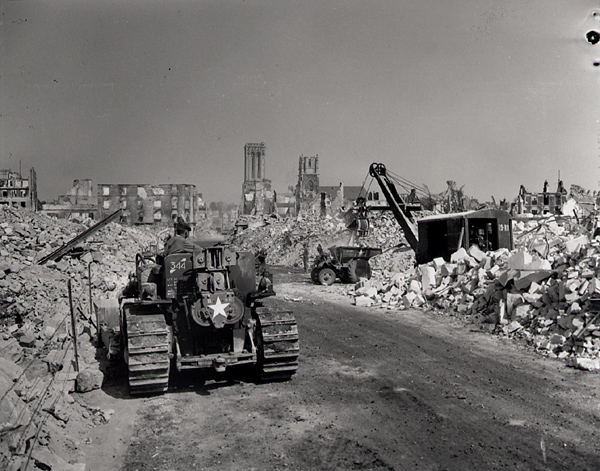Royal Engineers
"The role of the Engineer is a many any [sic] varied one, which can range from building to destroying bridges, clearing minefield and general entrenchment work. Engineers were also trained to fight as infantry so that they could defend themselves if necessary
"Until 1942 all an Engineer originally had to clear a minefield was nothing more than the tip of bayonet to feel for mines with, until the arrival in the Western Desert (of) a "Mine Detector". This did not always work, which meant the bayonet had to be used again, but as the war progressed they became more reliable. The advent of the flail tank also eased the burden of clearance from the engineers.
"To clear barbed wire, Bangalore Torpedo's, Satchel Charges, or even wire cutters were used. In the construction/repair of bridges or filling or large wholes, many materials would have been used including wood, 30ft Bridge laying tanks and of course the Bailey Bridge
"For the destruction of anything the use of TNT, Dynamite or even Plastic Explosive would have been used.
"To cap all of this most of the work was done while under fire!"
Source: The History of the British 7th Armoured Division, "The Desert Rats", Use of Arms.

Clearing by the Royal Canadian Engineers of rubble in order to start another road to the river bridges, Caen, Normandy, 4 August 1944.
Photo by Ken Bell. Department of National Defence / National Archives of Canada, PA-169342.
[I could tell you that the man on the bulldozer (tractor) was my father, Russell George Middleton, but that would be pure speculation based on wishful thinking at best. I will bring to your attention the lack of safety equipment (soft hat, no ROPS). A time, place and generation were getting the job done was 1st. Risks were a part of life. Job security was won through hard and loyal work not through the stroke of a bureaucrats pen. commentary by Rmē]
Middleton, Russell G, L56635, (8 July 1941 - 22 January 1946.) 1st Section, 1st Troop, 9th Field Park Squadron, Royal Canadian Engineers (RCE), 4th Armoured Division. -- the 9 Field Squadron supported the 10th Canadian Infantry Brigade (7 officers and 250 Other Ranks) -- 1939-45 Star, France and Germany Star, Defence Medal, Canadian Volunteer Service Medal and Clasp.
Field Park Squadrons were part of all Royal Engineer Regiments consisting of a Plant Troop, a Stores Troop, and a Workshops Troop, and H Q Troop. The engineers worked with all other Regiments performing Bomb disposal, Mine laying, Providing battle maps, repairing and building roads, airfields, and bridges; clearing mines, road-blocks, and other obstacles; filling-in craters and anti-tank ditches; and constructing facilities such as headquarters, barracks, and hospitals; these tasks and more were the responsibility of the Corps of Royal Canadian Engineers (RCE). The chief role of RCE troops therefore was to enable the army to move. In the mobile warfare conducted by the Canadian Army in Europe from 1943-45, their role required the engineers to work alongside other combat troops at the front, under fire, to open routes for the tanks and infantry to continue their assaults. In the earlier period of static defence in the United Kingdom, Canadian engineers built defences like beach obstacles, pill-boxes, anti-tank ditches, and minefields. They also improved British road-ways to facilitate the movement of military traffic, constructed military and air bases, and even built the Canadian wing of the Queen Elizabeth Hospital in East Grinstead.
Picture source: http://www.junobeach.org/e/4/can-tac-rce-e.htm